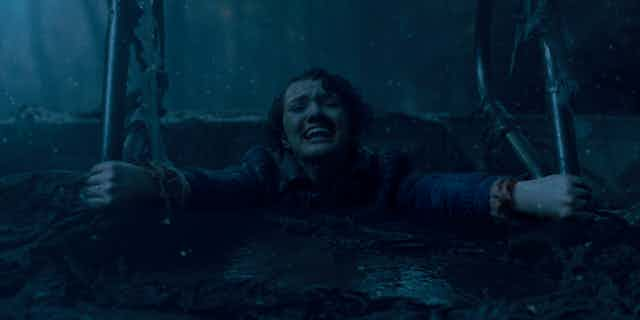Since it appeared on Netflix in July 2016, Stranger Things has attracted a cult following. From the outset, the show – which is set in 1980s Indiana – uses the toys, games and fashions of the decade to draw in its young adult viewers. It is the perfect nostalgic throwback for a generation which grew up on a diet of Steven Spielberg-style fantasy films such as ET, The Goonies and Jumanji – films where children go on epic adventures to return an alien to his home planet, dig up missing pirate treasure, or complete a magical board game.
As with these films, Stranger Things’ group of leading child characters have an adventure thrust upon them. The Dungeons and Dragons-playing middle schoolers are geeky outsiders – members of the audio-visual club, whose schooldays are plagued by bullying. And yet when one of their number goes missing they take it upon themselves to find him – and in the process uncover supernatural secrets in their hometown.
The plot is all-too familiar – thanks to many a movie from Disney. The animation giant has told of the plight of the lost child in its movies for decades now. Films such as The Lion King – along with older animations such as Bambi and Dumbo – urge the viewer to identify with a child deprived of (or separated from) one or both parents.
But Stranger Things is not a show for kids – and its creators the Duffer Brothers have not set out to be the new Disney. With a terrifying demo-gorgon on the loose and the prospect of spending eternity in the Upside Down – a parallel universe where monsters roam – Stranger Things has instead taken this plot theme in a very different direction, pushing grown-up viewers to relate instead to the adults of the story.
It feels familiar, but it is not the same: Stranger Things is the Upside Down to Disney’s saccharine universe.
Strange things, familiar formulas
In Disney’s The Lion King, we follow young Simba after he is told to flee the pridelands by uncle Scar after the death of his father Mufasa. In Stranger Things, on the other hand, when 12-year-old Will Byers is taken into the Upside Down, we follow the story in equal measures from the perspective of his mother and his young friends and older brother. In fact it is the adult characters that are either temporarily or permanently separated from their children who transform the well-used plight from old trope to fresh take.
Will’s mother Joyce Byers, police chief Jim Hopper, scientist Dr Martin Brenner – we are told that all of these characters have lost children and are either engaged in a struggle to be reunited with them or are defined by their grief. The characters and plot are all motivated by the hole left by an absent child – a void which cannot be filled by anything but the child itself.

The missing number
During the first series, viewers felt the familiar fear of being the lost child, but were given a new, almost schizophrenic identification, as they also related to the bereft parents. And though there is a sense of relief in Will Byers’s reunion with his mother, the same cannot be said for Eleven, who Will’s friends team up with her as they search. Eleven is a girl with supernatural abilities who was taken from her biological mother Terry Ives and brought up in a secret laboratory where her powers were pushed to the limits by Dr Brenner.
Throughout the series we want Eleven to find a new family, for her pain to be assuaged and for her to be welcomed into a human society from which she has always been alienated. The series demands that the horror of the lost child be put to an end. It is the reason we watch. Yet we are handed a peculiar and frustrating ending. Eleven vanishes into the Upside Down – and though Will is returns, he has brought some of its terrors back with him.
We sympathise with parents separated from their children, yet at the last moment Eleven is deprived of her new family, unable to return to her mother who is in a catatonic state. Identifying with the parents of lost children, we are forced to bear that very fact – we do not get our lost child back and the family is not restored. Even though Will is back at home, he too does not have the happy ending that we have come to expect.
Compounding this hypocrisy of unfinished families is the fact that Barbara “Barb” Holland’s mother, the only mother to actually have a child die in the first season, is entirely forgotten. Barb is taken into the Upside Down and killed in an early episode, seemingly as a stepping stone to develop the other teenage characters. This, the only grief worth grieving, the only genuine and unmitigated loss, is ignored. The horrific event – the death of a child – which the series in its entirety strives to resist occurs as a plot device within it.
Where Stranger Things will go from here is at present unknown. It has been confirmed that the show is going to use the second series to delve into Eleven’s back story, but given what viewers have already seen this is sure to be no tale of friendly woodland creatures and fairy godmothers.

